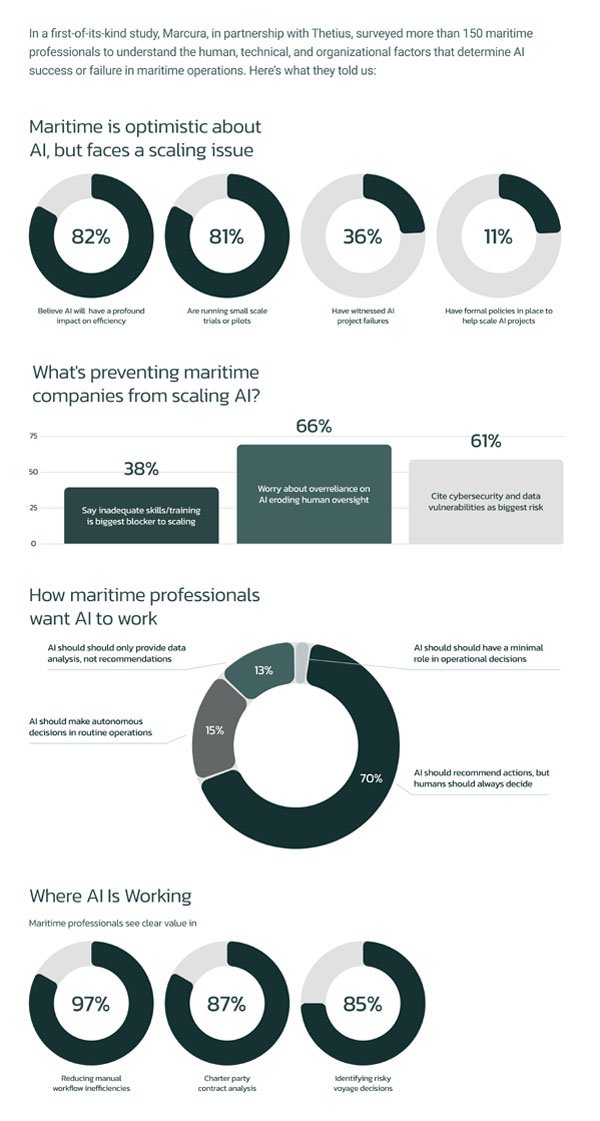Why 81% of Maritime Companies Are Piloting AI, Only 11% Are Ready to Scale

AI is now a boardroom priority in maritime, but ambition hasn’t yet turned into readiness. New industry research reveals a striking disconnect in maritime AI adoption. While 82 percent of maritime professionals believe AI can improve efficiency, only 23 percent of companies are training staff to use it. Even more telling, 81percent are running pilots, but only 11 percent have policies and guardrails needed to scale.
These were among the headlines from "Beyond the Hype: What the Maritime Industry Really Thinks About AI and Where They're Making It Work," a comprehensive study conducted by Thetius in partnership with Marcura.
The gap revealed in the research is less about algorithms than execution. It reflects a mismatch between board-level ambition and the organizational readiness required to turn promising proofs-of-concept into everyday tools on the bridge and in the back office.
The vision-execution gap
Maritime leaders now see AI as strategically important, but translating vision into operating practice is hard. Pilot experiments typically start with nebulous goals. Scaling requires clarity on the problem you are looking to address, it means confronting data quality, change management, governance and training, areas many organizations have not given sufficient attention.
During the webinar launching our findings, a fellow panelist and industry veteran Christian Vinther Christensen captured this dynamic perfectly: "The C-suite and leaders expressed genuine interest in AI, but how come only 23% of companies are training their staff? It tells me that we have a challenge in bridging that gap. It's very easy to say, 'yes of course we're interested in AI,' but actually you need to set aside resources, time and energy to embrace AI in practical ways."
Why projects disappoint
Our survey shows 37% of respondents have witnessed an AI project fail or cause harm to an existing process.
Nearly a quarter of respondents believe that the vendor community is guilty of overhyping AI solutions that fail to deliver the results they promise.
The real problem stems from a fundamental mismatch between what is being sold and what maritime actually needs. Many vendors deploy generic AI models trained on broad datasets that simply do not understand maritime's contextual nuances.
Without industry-specific training, even sophisticated AI can produce plausible-sounding but dangerously incorrect answers. This is why both vertical AI and rigorous evaluation frameworks matter. Systems must be built for maritime and continuously tested against real operational scenarios.
At Marcura, we are investing in AI evaluations (evals), a process of systematically testing our AI systems against maritime-specific benchmarks. These evaluation frameworks measure accuracy across operational scenarios, catch reliability issues before deployment, and provide the transparency needed to build organizational trust in AI-driven recommendations.
The Human Factor: What's Really Holding Teams Back
Perhaps the most revealing findings in the research relate to human concerns about AI adoption. While 82% see AI as beneficial, two-thirds worry that overreliance on AI could weaken human oversight. This is not technophobia. Instead, it is a legitimate recognition that maritime decisions carry significant financial and safety consequences.
Giuseppe Oliveri, Director at d'Amico, captured an essential insight during our research interviews: "In the shipping industry there is still that feeling of the person, the face-to-face relationships and not just the computer." Maritime deals hinge on personal trust, reputation, and real-time judgment calls built over years of experience. The fear is not that AI will assist with these decisions, it is that AI might replace the relationship dynamics that make deals happen.
The research shows that 70% of respondents say AI should recommend actions while humans make final decisions.
Here’s a good example of how that balance works in practice. During the pre-fixture process a chartering manager is comparing their working charter party against their base template to ensure they haven’t missed anything important or accepted unfavorable terms.
AI scans the document in seconds and flags four critical clauses that were omitted, issues that could have led to $120,000 in losses. But the AI doesn't make the decision; it surfaces the risk. The chartering manager, equipped with this insight, negotiates the terms before signing. The expertise and judgment remain human. The administrative burden of line-by-line contract review shifts to AI.
This is the path to trust: design AI that accelerates expert judgment rather than replacing it and makes escalation easy when a case falls outside trained context.
Moving Forward: From Aspiration to Implementation
For organizations ready to move beyond the hype, the Thetius research offers clear guidance.
1. Start with a clear understanding of the problem you are looking to solve. Run curiosity discovery sessions to identify where you are losing money, nominate AI champions within teams, and create curiosity maps to guide implementation priorities.
2. Invest in AI tools built specifically for maritime. Generic solutions will consistently fall short of industry-specific needs.
3. Foster agency and trust through comprehensive training programs that help employees understand, assess, and effectively use AI tools.
4. Implement governance frameworks that cover not just compliance but transparency, auditability, and internal accountability.
5. Measure and iterate. Establish clear KPIs that track business outcomes, not just efficiency gains. Track ROI clarity from the start and continuously refine your approach based on what the data reveals rather than assumptions.
The payoff for doing this now is material. The industry is compressing typical 10-15 year technology adoption cycles into just 2-3 years for AI. That speed creates competitive separation for companies that are ready, especially where the work product is document- and judgment-heavy.
Those who remain stuck between enthusiasm and action, uncertain about how to translate strategic vision into practical outcomes, will find the gap widening. Your organization faces a clear challenge: bridge the gap between knowing AI matters and knowing how to make it work for your organization.
About the author: Janani Yagnamurthy is the Vice President of Analytics and Market Research at Marcura, where she leads cutting edge digital transformation initiatives. With a focus on building vertical AI solutions tailored to the maritime sector, she has helped uncover new opportunities for operators, traders, and charterers empowering them to make sharper commercial decisions, reduce operational friction, and proactively manage risks.
This article is sponsored by Marcura. For more information visit Marcura online.
To see the full infographic click here.
The opinions expressed herein are the author's and not necessarily those of The Maritime Executive.

